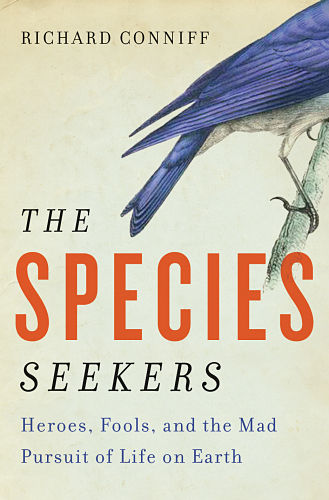
 My new book, chronicles the wild age of discovery when amateur enthusiasts scoured the earth for new species.
My new book, chronicles the wild age of discovery when amateur enthusiasts scoured the earth for new species.
A quiz on this exploratory time follows; my book can help you solve it. Stay tuned next week to see how you did.
1. Because they tended to ignore sexual selection as a factor in the evolution of species, generations of male scientists failed to notice what hard-to-miss phenomenon?
A) Displays by the bird of paradise.
B) Musth in elephants.
C) Changing colors in cuttlefish.
D) The love song of the crested bandicoot.
2. You know about U.S. presidents who have had species named in their honor. President George W. Bush, for instance, was lucky to attain scientific immortality on the back of a slime mold beetle, Agathidium bushi. But which president actually described a new species himself?
A) Teddy Roosevelt, who bagged a new species of piranha during his Amazonian explorations.
B) John Quincy Adams, who discovered a new catfish while skinnydipping in the Potomac.
C) Thomas Jefferson, whose work on mastodons helped make the elephant the symbol of the Republican Party.
D) Rutherford B. Hayes, who discovered a new songbird while out hunting (and shot it).
3. Why was John J. ÃÛèÖAPP resented as an upstart by some established American ornithologists?
A) He failed to pay homage to Alexander Wilson, father of American ornithology.
B) He was a Leatherstocking.
C) He knew nothing about birds.
D) He typically killed birds to obtain his models.
4. In what evolutionary controversy did the trumpeter swan serve as evidence? The one pondering...:
A) Are human races each a different species?
B) Are birds the modern descendants of dinosaurs?
C) Which came first: the chicken or the egg?
D) Is long-distance migration an innate or learned behavior?
5. Napolean’s first aide-de-camp, Col. Pierre Francois Marie Auguste Dejean, was also a coleopterist. What was his specialty?
A) He made precision rifle sights.
B) He collected beetles.
C) He was a battlefield engineer, adept at reading the land by studying the foliage.
D) He designed a new form of artillery.
6. What saved the intrepid female species seeker Mary Kingsley from a nasty end?
A) A strong, silent porter.
B) Her trusty elephant gun.
C) Her voluminous skirt.
D) The sharp pointed stick she always carried.
Answers coming next week!
